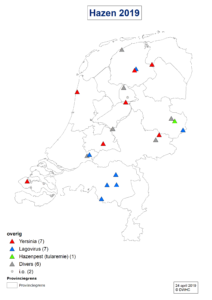Reappearance of tularaemia in the province of Overijssel
Tularaemia re-surfaced in a hare in the same area in the province of Overijssel, where in October 2018 two of the four examined dead hares were diagnosed with this disease.
The person who submitted this hare had found 6 dead hares in this area. The hares seemed to be in good condition, there was nothing out of the ordinary. One of those dead hares was submitted for post-mortem exam. This hare had a severe liver inflammation caused by the bacterium Francisella tularensis.
Other hare diseases 2019
 In 2019, 23 hares were examined at the DWHC until mid-April. Various causes of death have been found. In addition to the hare with tularemia, 7 hares died due to infection with bacteria Yersinia pseudotuberculosis and 7 hares due to infection with a lagovirus (EBHS or RHDV-2).
In 2019, 23 hares were examined at the DWHC until mid-April. Various causes of death have been found. In addition to the hare with tularemia, 7 hares died due to infection with bacteria Yersinia pseudotuberculosis and 7 hares due to infection with a lagovirus (EBHS or RHDV-2).
Death amongst European hares being caused by this bacteria is particularly seen during cold wet periods. Yersinia bacteria is widespread in nature, especially among voles. That is why the disease is also referred to as rodent disease.
EBHS and RHDV-2 are related viruses. EBHS was first diagnosed in hares in the 90s in the Netherlands. In 2015, RHDV-2 was diagnosed for the first time in a hare in the Netherlands.
More information on tularaemia
https://www.dwhc.nl/en/diseases/tularemie/
More information on Yersinia
https://www.dwhc.nl/en/diseases/yersinia-pseudotuberculosis/
https://www.dwhc.nl/en/yersinia-haas/
https://www.dwhc.nl/en/zoonosen-bij-hazen/
More information on EBHS and RHDV-2
https://www.dwhc.nl/en/haas-rhdv-2-nederland/



